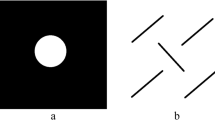Abstract
One of the most important features of saliency detection algorithms is to reduce the size of processing data for algorithms with higher processing size such as object detection algorithms. A main condition for algorithms of saliency detection to be used in detecting the object in the image is their low processing size and broadness of the application extent while having acceptable precision. In this article we introduce a Salient Object Detection method using Task Simulation (SOD-TS). This method has a low processing size and wide functional domain using task simulation (object model). Our proposed method has a wide range of application including ship detection, words and letter detection in texts, etc. Relying on the task simulation (object model), SOD-TS method detects the salient object which is the best response to the current task. It uses the information of the frequency domain.












Similar content being viewed by others
Change history
11 March 2019
The article Salient object detection using the phase information and object model, written by Hooman Afsharirad and Seyed Alireza Seyedin, was originally published electronically on the publisher’s internet portal (currently SpringerLink) on February 7, 2019 with open access.
References
Achanta R, Susstrunk S (2010) Saliency detection using maximum symmetric surround. IEEE ICIP: 2653–2656
Achanta R, Estrada F, Wils P, Susstrunk S (2008) Salient region detection and segmentation. Comp Vis Sys
Achanta R, Hemami S, Estrada F, Susstrunk S (2009) Frequency-tuned salient region detection. IEEE CVPR
Aiger D, Talbot H (2010) The phase-only transform for unsupervised surface defect detection. Computer Vision and Pattern Recognition (CVPR) IEEE Conference
Aytekin C, Kiranyaz S, Gabbouj M (2014) Automatic object segmentation by quantum cuts. IEEE ICPR: 112–117
Bhatnagar G, Wu QMJ, Raman B (2013) Discrete fractional wavelet transform and its application to multiple encryption. Inf Sci 223:297–316
Borji A et al (2015) Salient object detection: a benchmark. IEEE Trans Image Process 24(12)
Borji A, Itti L (2013) State-of-the-art in visual attention modeling. IEEE Trans Pattern Anal Mach Intell 35(1)
Borji A, Sihite DN, Itti L (2013) What stands out in a scene? A study of human explicit saliency judgment. Vis Res 91(0):62–77
Chang K-Y, Liu T-L, Chen H-T, Lai S-H, (2011) Fusing generic objectness and visual saliency for salient object detection. IEEE ICCV: 914–921
Chen T, Lin L, Liu L, Luo X, Li X (2016) Deep image saliency computing via progressive representation learning. IEEE Trans Neural Netw Learn Syst 27(6):1135
Cheng M-M, Warrell J, Lin W-Y, Zheng S, Vineet V, Crook N (2013) Efficient salient region detection with soft image abstraction. IEEE ICCV: 1529–1536
Cheng M-M et al. (2015) Global contrast based salient region detection. IEEE TPAMI
Cheng M-M, Mitra NJ, Huang X, Torr PHS, Hu S-M (2015) Global contrast based salient region detection. IEEE TPAMI
Duan L, Wu C, Miao J, Qing L, Fu Y (2011) Visual saliency detection by spatially weighted dissimilarity. IEEE CVPR: 473–480
Goferman S, Zelnik-Manor L, Tal A (2012) Context-aware saliency detection. IEEE TPAMI 34(10):1915–1926
Gue C, Ma Q, Zhang L (2008) Spatiotemporal saliency detection using phase spectrum of quaternion Fourier transform. Proc IEEE Int Conf Comput Vision Pattern Recogn
Hou X, Zhang L (2007) Saliency detection: a spectral residual approach. Proc IEEE Int Conf Comput Vision Pattern Recogn,: 1–8
Jiang H, Wang J, Yuan Z, Liu T, Zheng N, (2011) Automatic salient object segmentation based on context and shape prior. BMVC
Jiang B, Zhang L, Lu H, Yang C, Yang M-H (2013) Saliency detection via absorbing markov chain. IEEE ICCV
Jiang P, Ling H, Yu J, Peng J (2013) Salient region detection by ufo: uniqueness, focusness and objectness. IEEE ICCV
Kim J, Han D, Tai Y-W, Kim J (2014) Salient region detection via high-dimensional color transform. IEEE CVPR
Lee G, Tai YW, Kim J (2016) Deep saliency with encoded low level distance map and high level features. 2016 IEEE Conf Comput Vision Pattern Recognition (CVPR): 660–668
Li G, Yu Y (2015) Visual saliency based on multiscale deep features. Computer Vision and Pattern Recognition: 5455–5463
Li J, Levine MD, An X (2007) IEEE Transactions on Pattern Analysis and Machine Intelligence. Class files 6(1)
Li X, Li Y, Shen C, Dick AR, van den Hengel A (2013) Contextual hypergraph modeling for salient object detection. IEEE ICCV: 3328–3335
Li X, Lu H, Zhang L, Ruan X, Yang M-H (2013) Saliency detection via dense and sparse reconstruction. IEEE ICCV
Li J, Levine MD, An X, Xu X, He H (2013) Visual saliency based on scale-space analysis in the frequency domain. IEEE Trans Pattern Anal Mach Intell 35(4):996–1010
Liu N, Han J (2018) A deep spatial contextual long-term recurrent convolutional network for saliency detection. IEEE Trans. Image Process
Liu Z, Zou W, Le Meur O (2013) Saliency tree: a novel saliency detection framework. IEEE TIP
Margolin R, Tal A, Zelnik-Manor L (2013) What makes a patch distinct?. IEEE CVPR: 1139–1146
Margolin R, Zelnik-Manor L, Tal A (2013) Saliency for image manipulation. Vis Comput: 1–12
Movahedi V, Elder JH (2010) Design and perceptual validation of performance measures for salient object segmentation. IEEE CVPRW
Perazzi F, Krahenbuhl P, Pritch Y, Hornung A (2012) Saliency filters: contrast based filtering for salient region detection. IEEE CVPR: 733–740
Rahtu E, Kannala J, Salo M, Heikkila J (2010) Segmenting salient objects from images and videos. ECCV
Siva P, Russell C, Xiang T, Agapito L (2013) Looking beyond the image: unsupervised learning for object saliency and detection. IEEE CVPR: 3238–3245
Tavakoli HR, Rahtu E, Heikkila J (2011) Fast and efficient saliency detection using sparse sampling and kernel density estimation. Scandinavian conference on image analysis: 666–675
Tong N, Lu H, Ruan X, Yang M-H (2015) Salient object detection via bootstrap learning. Proceedings of the IEEE Conference on Computer Vision and Pattern Recognition: 1884–1892
Tong N, Lu H, Zhang Y, Ruan X (2015) Salient object detection via global and local cues. Pattern Recogn 48(10):3258–3267
Wang J, Lu H, Li X, Tong N, Liu W (2015) Saliency detection via background and foreground seed selection. Neurocomputing 152:359–368
Wang L, Lu H, Xiang R, Yang MH (2015) Deep networks for saliency detection via local estimation and global search. Comput Vision Pattern Recogn: 3183–3192
Wang J, Jiang H, Yuan Z, Cheng M-M, Hu X, Zheng N (2017) Salient object detection: a discriminative regional feature integration approach. Int J Comput Vis 123(2):251–268
Xie Y, Lu H, Yang M-H (2013) Bayesian saliency via low and mid-level cues. IEEE TIP 22(5)
Yang C, Zhang L, Lu H, Ruan X, Yang M-H (2013) Saliency detection via graph-based manifold ranking. IEEE CVPR
Yang C, Zhang L, Lu H (2013) Graph-regularized saliency detection with convex-hull-based center prior. IEEE Signal Process Lett 20(7):637–640
You X, Du L, Cheung Y-m, Chen Q (2010) A blind watermarking scheme using new nontensor product wavelet filter banks. IEEE Trans Image Process 19(12):3271–3284
Zhang J et al (2018) Top-down neural attention by excitation backprop. Int J Comput Vis 126:1084–1102
Zhu D (2018) Salient object detection via a local and global method based on deep residual network. J Vis Commun Image Represent 54
Zhu W, Liang S, Wei Y, Sun J (2014) Saliency optimization from robust background detection. IEEE CVPR
Author information
Authors and Affiliations
Corresponding author
Additional information
Publisher’s note
Springer Nature remains neutral with regard to jurisdictional claims in published maps and institutional affiliations.
The original version of this article was revised due to retrospective open access.
Rights and permissions
About this article
Cite this article
Afsharirad, H., Seyedin, S.A. Salient object detection using the phase information and object model. Multimed Tools Appl 78, 19061–19080 (2019). https://doi.org/10.1007/s11042-019-7255-7
Received:
Revised:
Accepted:
Published:
Issue Date:
DOI: https://doi.org/10.1007/s11042-019-7255-7




